Exfoliation Syndrome and Exfoliative Glaucoma
Exfoliation syndrome is the most common identifiable cause of open-angle glaucoma worldwide (1). It is a systemic disorder with important eye manifestations, including development of open- and closed-angle glaucoma and of cataract with zonular instability (Table 15.1, Fig. 15.1A, and Fig. 15.2) (2). It may also be associated with increased systemic risk of cardiovascular disorders (3). In this chapter, we present an epidemiologic, clinical, and pathophysiologic overview of exfoliation syndrome and exfoliative glaucoma.
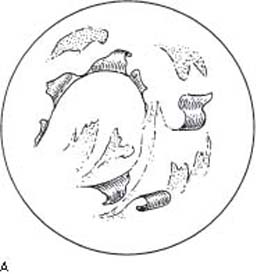
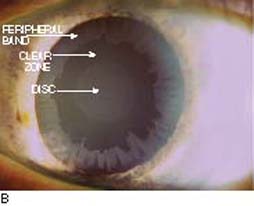
Figure 15.1 Anterior lens capsule delamination and exfoliation syndrome. A: Capsular delamination, also sometimes termed exfoliation of the lens capsule characterized by thin, clear membranes separating from the anterior lens capsule and often curling at the margins. B: Exfoliation syndrome is demonstrated by three distinct zones: a central, translucent disc; a clear zone; and a peripheral granular zone, often with radial striations. (Courtesy of Joseph A. Halabis, OD.)
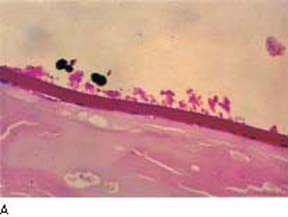
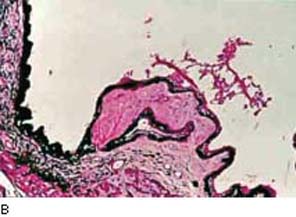
Figure 15.2 A: Exfoliation fibers on the lens capsule. The dark areas are pigment aggregates (PAS, ×146). (From Kincaid MC. Pathology of the lens. In: Tasman W, Jaeger EA, eds. Duane’s Foundations of Clinical Ophthalmology. Vol. 3. Philadelphia, PA: Lippincott Williams & Wilkins; chap 12.) B: Light micrograph of exfoliative material overlying ciliary body process (PAS, ×100). (Courtesy of Marilyn C. Kincaid, MD, Armed Forces Institute of Pathology. From Khaimi MA, Skuta GL, Morgan RK. Exfoliation syndrome, pigment dispersion syndrome, and the associated glaucomas. In: Tasman W, Jaeger EA, eds. Duane’s Clinical Ophthalmology. Vol. 3. Philadelphia, PA: Lippincott Williams & Wilkins; chap 54B: 2008.)

TERMINOLOGY
In 1917, Lindberg (4) described cases of chronic glaucoma in which flakes of whitish material adhered to the pupillary border of the iris. Subsequent study revealed that this material is derived from various sources in the anterior segment. Over the years, there has been some debate regarding nomenclature for this disorder. Given the rarity of true lens capsule delamination (sometimes referred to as exfoliation of the lens capsule) we have chosen to use the term exfoliation syndrome throughout this chapter; when exfoliation syndrome is accompanied by glaucoma, we use the term exfoliative glaucoma. However, readers should be aware that in the literature, the terms pseudoexfoliation syndrome and pseudoexfoliation glaucoma, as well as capsular glaucoma, continue to be used.
Capsular Delamination
In capsular delamination, superficial layers of lens capsule separate from the deeper capsular layers to form scroll-like margins and occasionally to float in the anterior chamber as thin, clear membranes (Fig. 15.1A). Elschnig (5) first described this condition in glassblowers, leading to the term glassblower cataracts, and it was subsequently found that extended exposure to infrared radiation in a variety of occupations was responsible. The condition is uncommon because of the widespread use of protective goggles by exposed workers, although clinically similar cases may be seen in association with trauma, intraocular inflammation, and idiopathically, usually with advanced age (6–10). Glaucoma is not a common feature of this disorder. The condition has been called capsular delamination or exfoliation of the lens capsule, prompting Dvorak-Theobald (11) to suggest the term true exfoliation of the lens capsule, to distinguish it from “exfoliation.”
EPIDEMIOLOGY
The prevalence of exfoliation increases dramatically with age and varies considerably among populations worldwide (12). The tremendous variation in prevalence of exfoliation syndrome is caused by true differences in the populations studied, but it may also vary because of other factors such as differences in age, environmental influences, definition of exfoliation syndrome, and examination techniques. Exfoliation syndrome is more common in older age-groups, with most cases occurring in the late 60s and early 70s. The condition may be unilateral or bilateral, and over half of unilateral cases become bilateral over a 20-year period (13).
Geographic and ethnic differences appear to be important, with exfoliation syndrome prevalences worldwide varying from 0% in Inuit populations in Alaska, Greenland, and Canada to 38% in the Navajo population in the United States. Exfoliation syndrome is also widely prevalent in the Scandinavian countries, Europe, the United Kingdom, and the Middle East. Exfoliation syndrome has been found in East and South Africa, India, Southeast Asia, Australia, and many regions in South America.
Within countries, the prevalence can vary from region to region. Ringvold (14) reported rates of 10.2%, 19.6%, and 21.0% in three closely situated municipalities in central Norway. The influence of race differs among geographic populations. In South Africa, exfoliation syndrome was found in 20% of black patients with open-angle glaucoma, compared with 1.4% of whites (15), whereas a study in southern Louisiana revealed a prevalence of 0.3% in blacks and 2.0% in whites (16). Geographic distribution patterns may be explained by regional gene pools or by environmental influences. Differences in altitude and ultraviolet light exposure have been suggested, but the evidence to date for either factor is marginal (17). There is no clear relation between exfoliation syndrome prevalence and sex. The percentage of exfoliation syndrome patients with glaucoma is different for every population. Overall, studies indicate about 40% of exfoliation syndrome patients will develop glaucoma (18). The reported prevalence of exfoliation syndrome among patients with open-angle glaucoma also shows considerable geographic variation, with 26% in Denmark, 75% in Sweden, 60% in Norway, 46.9% in the Mediterranean area of Turkey, and 44.5% in the northwest of Spain, compared with reports of 1% to 12% in the United States (16,19–24).
More large-scale, population-based studies need to be conducted with standardized classification criteria, particularly outside of Europe, to determine a more accurate worldwide distribution of exfoliation syndrome and exfoliative glaucoma.
CLINICAL AND PATHOLOGIC FEATURES
Corneal Changes
Flakes of exfoliative material and pigment accumulation may be seen on the corneal endothelium (Fig. 15.3A), scattered diffusely or in the form of a vertical spindle similar to the Krukenberg spindle in pigmentary glaucoma. Specular microscopy of the corneal endothelium has revealed a significantly lower-than-normal cell density in eyes with the exfoliation syndrome and changes in cell size and shape (25). These findings have also been observed in the unaffected eye of unilateral cases, leading the researchers to suggest that these corneal endothelial changes might serve as an early sign of the disorder (25). Ultrastructural studies have revealed clumps of exfoliative material adhering to the corneal endothelium and incorporated into the posterior Descemet membrane, which the investigators believe indicate that the exfoliative material was formed by degenerative endothelial cells (26) (Fig. 15.3B,C).
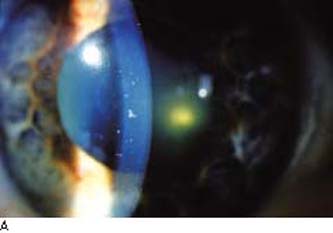
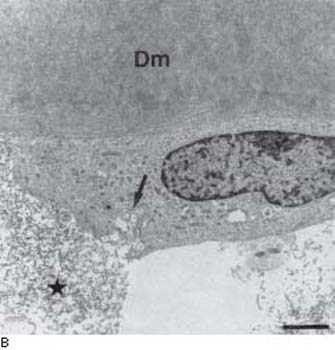
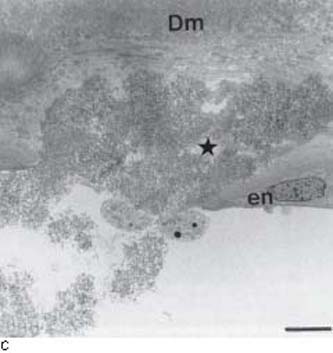
Figure 15.3 Exfoliation syndrome endotheliopathy. A: Exfoliation syndrome flakes on corneal endothelium. B: Apparent production of exfoliation syndrome fibers (asterisk) by a corneal endothelial cell (arrow) (bar = 2 µm). Dm, Descemet membrane. C: Incorporation of exfoliative material (asterisk) into Descemet membrane by an overgrowing endothelial cell (en) (bar = 5 µm). (B, C from Naumann GO, Schlötzer-Schrehardt U, Kuchle M. Exfoliation syndrome for the comprehensive ophthalmologist: intraocular and systemic manifestations. Ophthalmology. 1998; 105(6):951–968, with permission.)
It has been suggested that corneal endotheliopathy in exfoliation syndrome can give rise to an appearance of guttata but is distinct from Fuchs endothelial corneal dystrophy or pseudophakic or aphakic bullous keratopathy (27,28). Exfoliation syndrome endotheliopathy differs from Fuchs endothelial corneal dystrophy in that the former typically has less and more diffusely distributed guttata-like structures and is associated with more melanin dispersion in the anterior segment and peripupillary iris atrophy.
Lens, Zonule, and Ciliary Body Changes
The characteristic appearance of exfoliative material on the anterior lens capsule has three distinct zones (Fig. 15.1B): a translucent, central disc with occasional curled edges; a clear zone, probably corresponding to contact with the moving iris; and a peripheral granular zone, which may have radial striations (29). The central zone is absent in 20% of cases or more, but the peripheral defect is a consistent finding, and the pupil must be dilated before the lens changes can be seen in some cases.
A precapsular film has been noted on the anterior lens capsule of many older individuals, which has a ground-glass appearance and has been shown by ultrastructural studies to be a fibrillar layer similar to exfoliative material. The precapsular layer may be a precursor of the exfoliation syndrome (Fig. 15.4).
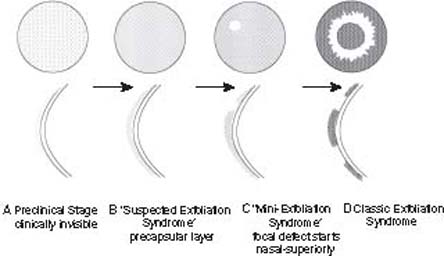
Figure 15.4 Clinical classification of exfoliation syndrome based on morphologic alterations of the anterior lens capsule. A: Preclinical stage. B: Suspected exfoliation syndrome. C: Mini-exfoliation syndrome. D: Classic exfoliation syndrome. (Modified from Naumann GO, Schlötzer-Schrehardt U, Kuchle M. Exfoliation syndrome for the comprehensive ophthalmologist: intraocular and systemic manifestations. Ophthalmology. 1998;105(6):951–968, with permission.)
Cataracts occur frequently in eyes with exfoliation syndrome (24). Although this may be in part a function of the age of the patient population, cataracts in eyes with exfoliation syndrome have a higher percentage of nuclear opacities and smaller percentage of cortical and supranuclear opacities (30). In patients with uniocular exfoliation syndrome, the involved eye typically has the more advanced cataract. The Reykjavik Eye Study, however, found no association between cataract and exfoliation (31).
Exfoliative material may be detected earliest on the ciliary processes and zonules (Fig. 15.5). In patients with apparently unilateral exfoliation syndrome, cycloscopy reveals exfoliative material on the ciliary processes, zonules, or both in 77% of fellow eyes in which exfoliative material was not clinically visible on the lens surface or pupillary border (32). By using gonioscopy, exfoliative material can be observed on ciliary processes through a patent basal iridectomy.
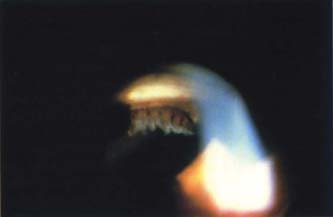
Figure 15.5 Exfoliative material on ciliary processes as seen through sector iridectomy in an aphakic eye. (From Khaimi MA, Skuta GL, Morgan RK. Exfoliation syndrome, pigment dispersion syndrome, and the associated glaucomas. In: Tasman W, Jaeger EA, eds. Duane’s Clinical Ophthalmology, Vol. 3. Philadelphia, PA: Lippincott Williams & Wilkins; 2008:chap 54B.)
Involvement of the zonules can lead to lens subluxation and phacodonesis (33). This instability of the zonules can be understood by examining exfoliation aggregates at the origin and anchorage of the zonules between nonpigmented ciliary epithelial cells and at the insertion of the zonules on the pre-equatorial region of the lens (Fig. 15.6). In these areas, exfoliation aggregates erupt through the basement membrane and involve the zonular lamellae, producing areas of weakness (34). Proteolytic enzymes in the exfoliative material may facilitate zonular disintegration. These alterations, which can lead to lens instability, need to be kept in mind for all patients with exfoliation syndrome undergoing cataract surgery.
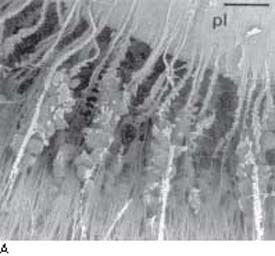
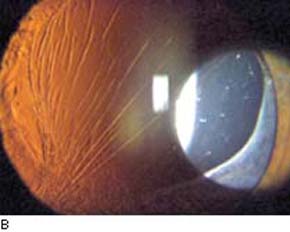
Figure 15.6 Exfoliation syndrome zonulopathy. A: Scanning electron micrograph shows an accumulation of exfoliation syndrome material on zonules in the region of the ciliary processes (pars plicata) and the posterior lens equator (pl). Zonules appear to be loosened and, in some cases, broken. (From Naumann GO, Schlötzer-Schrehardt U, Kuchle M. Exfoliation syndrome for the comprehensive ophthalmologist: intraocular and systemic manifestations. Ophthalmology. 1998;105(6):951–968, with permission.) B: Exfoliation syndrome has created zonular tension so that the posterior capsule tension is flaccid, which makes cortex removal incomplete and capsular vacuuming impossible. As fibrosis progressed, substantial oblique striae developed with their apex at the area of retained cortex. (From Davison JA, et al. Intraocular lenses. In: Tasman W, Jaeger EA, eds. Duane’s Clinical Ophthalmology. Vol. 6. Philadelphia, PA: Lippincott Williams & Wilkins; chap 11.)
Iris Changes
Exfoliative material may also be seen as white flecks on the pupillary margin of the iris, with loss of pigment at the pupillary ruff (35) (Fig. 15.7A). Iris transillumination typically reveals a moth-eaten pattern near the pupillary sphincter (Fig. 15.7B), and many patients also have diffuse midperipheral transillumination defects (35,36). Light and scanning electron microscopy demonstrate exfoliative material on the posterior surface of the iris. Fluorescein angiographic studies of the iris have revealed hypoperfusion, peripupillary leakage, and neovascularization (37). These findings are more pronounced with increasing age of the patient, longer duration of the disease, and the presence of glaucoma, and they may represent secondary features of the disease. Ultrastructural studies suggest that vascular abnormalities or abnormal extracellular matrix production causes tissue hypoxia (38). Conversely, it has been observed that eyes with transient ischemic attacks have an increased incidence of abnormal iris transillumination and exfoliative material, suggesting that hypoperfusion may be a contributory factor in the development of the exfoliation syndrome (39,40).
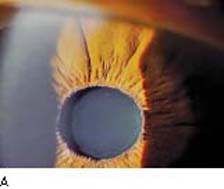
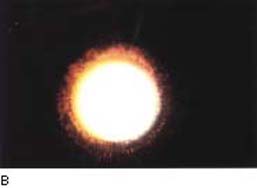
Figure 15.7 Exfoliation syndrome iridopathy. A: Exfoliative material at pupil border (called Fnock by Icelanders). (Courtesy of Joseph A. Halabis, OD.) B: “Moth-eaten” pattern of peripupillary transillumination defects from degeneration of the iris sphincter muscle. (From Khaimi MA, Skuta GL, Morgan RK. Exfoliation syndrome, pigment dispersion syndrome, and the associated glaucomas. In: Tasman W, Jaeger EA, eds. Duane’s Clinical Ophthalmology, Vol. 3. Philadelphia, PA: Lippincott Williams & Wilkins; 2008:chap 54B.)
Whether a primary or secondary feature, the iris hypoxia is associated with atrophy of the iris pigment epithelium, stroma, and muscle cells (38). Atrophy of the pigment epithelium may be associated with anterior chamber melanin dispersion, which may be seen as a whorl-like pattern of pigment particles on the iris sphincter and pigment deposition on the peripheral iris (35), whereas atrophy of the muscle cells may account for the poor mydriasis, which is also a typical finding in the exfoliation syndrome (38).
Gonioscopic Findings
The exfoliation syndrome is associated with excessive pigment dispersion, which leads to increased trabecular meshwork pigmentation. The pigmentation of the meshwork has a more variegated (uneven) distribution than that seen in pigmentary glaucoma and may be associated with flecks of exfoliative material (Fig. 15.8). An accumulation of pigment may also be seen along the Schwalbe line, which has been termed the Sampaolesi line (41). In eyes with marked asymmetry of meshwork pigmentation, glaucoma is more common in the more pigmented eye. However, increased pigmentation of the trabecular meshwork has also been observed in the fellow eye without apparent exfoliation syndrome, and it has been suggested that this may be the earliest detectable sign of exfoliation syndrome (42). Although the anterior chamber depth is normal in most eyes with the exfoliation syndrome, the anterior chamber angle is occludable in a high percentage of cases (43). The latter cases typically have a shallower central and peripheral anterior chamber depths (44). In studies of patients with the exfoliation syndrome, 9% to 18% had angles that were considered to be occludable (42,45), and 14% had evidence of angle closure on the basis of peripheral anterior synechiae (42).
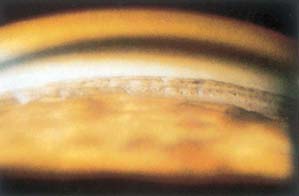
Figure 15.8 Gonioscopic view of an eye with exfoliation syndrome shows irregular pigmentation of trabecular meshwork and white flecks of exfoliative material.
Stay updated, free articles. Join our Telegram channel

Full access? Get Clinical Tree


